小学1-6年级英语句型转换方法归纳汇总
- 格式:docx
- 大小:13.18 KB
- 文档页数:6
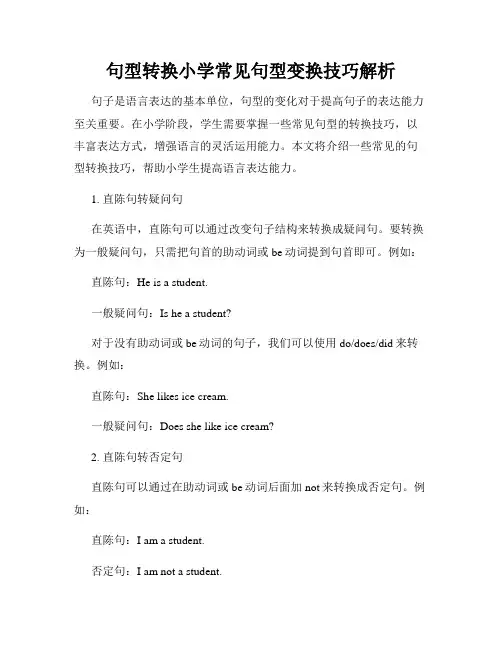
句型转换小学常见句型变换技巧解析句子是语言表达的基本单位,句型的变化对于提高句子的表达能力至关重要。
在小学阶段,学生需要掌握一些常见句型的转换技巧,以丰富表达方式,增强语言的灵活运用能力。
本文将介绍一些常见的句型转换技巧,帮助小学生提高语言表达能力。
1. 直陈句转疑问句在英语中,直陈句可以通过改变句子结构来转换成疑问句。
要转换为一般疑问句,只需把句首的助动词或be动词提到句首即可。
例如:直陈句:He is a student.一般疑问句:Is he a student?对于没有助动词或be动词的句子,我们可以使用do/does/did来转换。
例如:直陈句:She likes ice cream.一般疑问句:Does she like ice cream?2. 直陈句转否定句直陈句可以通过在助动词或be动词后面加not来转换成否定句。
例如:直陈句:I am a student.否定句:I am not a student.对于没有助动词或be动词的句子,我们可以使用do/does/did来转换。
例如:直陈句:They play soccer.否定句:They do not play soccer.3. 陈述句转祈使句陈述句可以通过去掉主语和be动词来转换成祈使句。
例如:陈述句:You are a good student.祈使句:Be a good student.4. 直陈句转感叹句直陈句可以通过在句首加上“What”、“How”等疑问词或感叹词来转换成感叹句。
例如:直陈句:The book is interesting.感叹句:How interesting the book is!5. 陈述句转条件句陈述句可以通过在句首加上if来转换成条件句。
例如:陈述句:I will go to the park tomorrow.条件句:If I go to the park tomorrow.6. 直陈句转间接引语直陈句可以通过改变人称和时态,引入引号和连词来转换成间接引语。
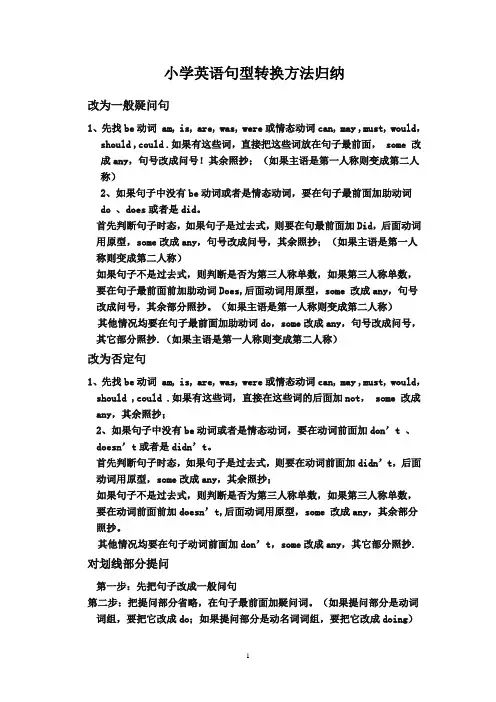
小学英语句型转换方法归纳改为一般疑问句1、先找be动词 am, is, are, was, were或情态动词can, may ,must, would,should ,could .如果有这些词,直接把这些词放在句子最前面, some 改成any,句号改成问号!其余照抄;(如果主语是第一人称则变成第二人称)2、如果句子中没有be动词或者是情态动词,要在句子最前面加助动词do 、does或者是did。
首先判断句子时态,如果句子是过去式,则要在句最前面加Did,后面动词用原型,some改成any,句号改成问号,其余照抄;(如果主语是第一人称则变成第二人称)如果句子不是过去式,则判断是否为第三人称单数,如果第三人称单数,要在句子最前面前加助动词Does,后面动词用原型,some 改成any,句号改成问号,其余部分照抄。
(如果主语是第一人称则变成第二人称)其他情况均要在句子最前面加助动词do,some改成any,句号改成问号,其它部分照抄.(如果主语是第一人称则变成第二人称)改为否定句1、先找be动词 am, is, are, was, were或情态动词can, may ,must, would,should ,could .如果有这些词,直接在这些词的后面加not, some 改成any,其余照抄;2、如果句子中没有be动词或者是情态动词,要在动词前面加don’t 、doesn’t或者是didn’t。
首先判断句子时态,如果句子是过去式,则要在动词前面加didn’t,后面动词用原型,some改成any,其余照抄;如果句子不是过去式,则判断是否为第三人称单数,如果第三人称单数,要在动词前面前加doesn’t,后面动词用原型,some 改成any,其余部分照抄。
其他情况均要在句子动词前面加don’t,some改成any,其它部分照抄. 对划线部分提问第一步:先把句子改成一般问句第二步:把提问部分省略,在句子最前面加疑问词。
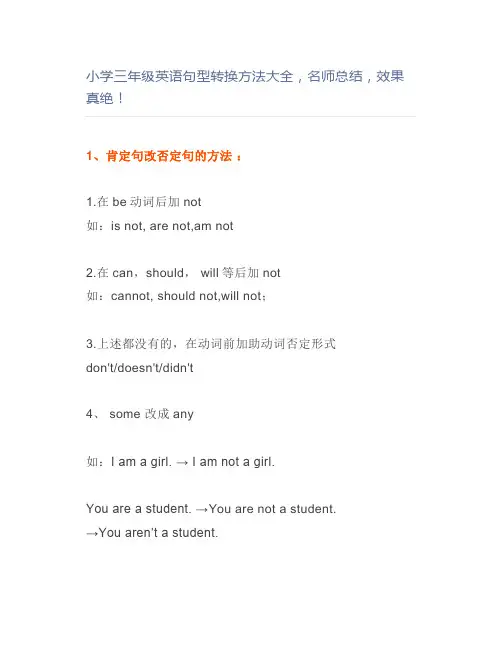
小学三年级英语句型转换方法大全,名师总结,效果真绝!1、肯定句改否定句的方法:1.在be动词后加not如:is not, are not,am not2.在can,should, will等后加not如:cannot, should not,will not;3.上述都没有的,在动词前加助动词否定形式don't/doesn't/didn't4、 some 改成any如:I am a girl. → I am not a girl.You are a student. →You are not a student.→You aren’t a student.This is Tom’s bag, → This is not Tom’s bag.→ This isn’t Tom’s bag.2、肯定句改一般疑问句的方法1.把be动词放在句首,剩下的照抄(some 改成any,I改成you,my改成your)句点改成问号。
2.把can,shall, will等放到句首,剩下的照抄(some 改成any,I改成you,my改成your)句点改成问号。
3.上述都没有的,在句首请助动词Do/Does/Did帮忙,剩下的照抄,(some 改成any,I改成you,my改成your,)句点改成问号注意:句首的第一个字母要大写,句尾标点应为“?”如:I am in Class 6. →Are you in Class 6?You are from America.→Are you from America?It is an orange. →Is it an orange?4、就一般疑问句回答一般疑问句有两种回答,即:肯定回答和否定回答。
其中,肯定回答用yes,否定回答用no。
语句顺序为:Yes + 主语 + am /is/ are/was/were.|can.|do/does/did|; No + 主语+ am not/ isn’t/ aren’t 如:—Are you an English teacher?→Yes, I am. /No, I am not.—Is that a bird?→Yes, it is./ No, it isn’t.3、对划线部分提问“就划线部分提问”是小学阶段英语学习的难点,但是一旦掌握了规律,就变得容易多了。
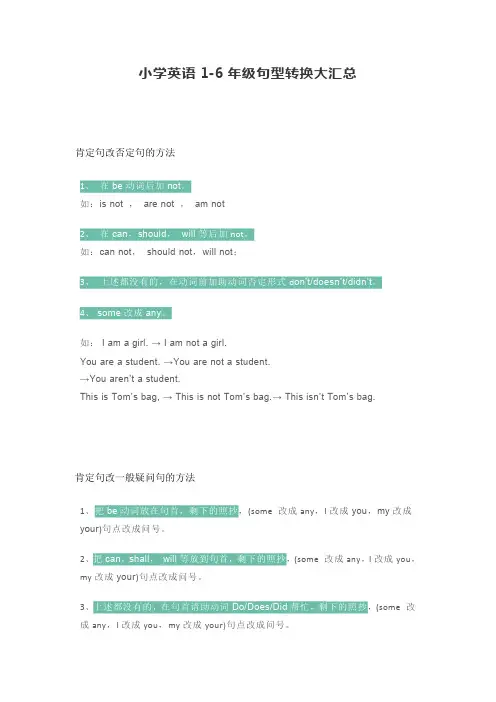
小学英语1-6年级句型转换大汇总肯定句改否定句的方法1如:is not,are not,am not2如:can not,should not,will not;34如:I am a girl.→I am not a girl.You are a student.→You are not a student.→You aren’t a student.This is Tom’s bag,→This is not Tom’s bag.→This isn’t Tom’s bag.肯定句改一般疑问句的方法1、,(some改成any,I改成you,my改成your)句点改成问号。
2、,(some改成any,I改成you,my改成your)句点改成问号。
3、,(some改成any,I改成you,my改成your)句点改成问号。
注意:。
如:I am in Class6.→Are you in Class6?You are from America.→Are you from America?It is an orange.→Is it an orange?4、就一般疑问句回答一般疑问句有两种回答,即:和。
其中,肯定回答用yes,否定回答用no。
:Yes+主语+am/is/are/was/were.|can.|do/does/did|;No+主语+am not/isn’t/aren’t.如:—Are you an English teacher?→Yes,I am./No,I am not.—Is that a bird?→Yes,it is./No,it isn’t.对划线部分提问“就划线部分提问”是小学阶段英语学习的难点,但是一旦掌握了规律,就变得容易多了。
小学英语对划线部分提问之答题口诀::用正确的疑问词代替划线部分:把疑问词移至句首:颠倒主谓语,但对主语或其定语提问时除外(some改成any,I改成you,my改成your):照抄句子剩余部分∙划线部分是“事或物”,特殊疑问词用what∙如:This is a book.---What is this?I often play football on Saturdays.---What do you often do on Saturdays?∙划线部分是“人”,特殊疑问词用who∙如:He is my brother.---Who is he?∙划线部分是“地点”,特殊疑问词用where∙如:The box is on the desk.---Where is the box?∙划线部分是“时间”,特殊疑问词用what time或when∙如:I t's seven twenty.---What time is it?I usually get up at six.---When do you usually get up?∙划线部分是“年龄”,特殊疑问词用how old∙如:I am twelve.---How old are you?My father is thirty-three.---How old is your father?∙划线部分是“职业”,特殊疑问词用what∙如:Mike is a worker.---What is Mike?∙划线部分是“颜色”,特殊疑问词用what colour∙如:My hat is blue.---What colour is your hat?∙划线部分是“数量”,特殊疑问词用how many或how much∙如:I can see five kites.---How many kites can you see?There is some milk in the glass.---How much milk is there in the glass?∙划线部分是“多少钱”,特殊疑问词用how much∙如:This pen is nine yuan.---How much is this pen?∙划线部分是“形容词性物主代词或名词性物主代词”,特殊疑问词用whose ∙如:That is my book.---Whose book is that?The bag is yours.---Whose is the bag?以下口诀一定要记住1.问“谁”用who;2.问“谁的”,用whose;3.问“地点哪里”,用where;4.问“原因”,用why;5.问“身体状况”,用how;6.问“方式”,用how;7.问“年龄”,用how old;8.问“多少”,用how many;9.问"价钱”用how much;10.问“哪一个”,用which;11.问“什么”,用what;12.问“职业”,用what;13.问“颜色”,用what colour;14.问“星期”,用what day;15.问什么学科,用what subject;16.问“什么时候”,用when;17.问几点用What’s the time?或What time is it?附小学英语必考的62个句型句型1:There+be+主语+地点状语/时间状语There’s a boat in the river.河里有条船。
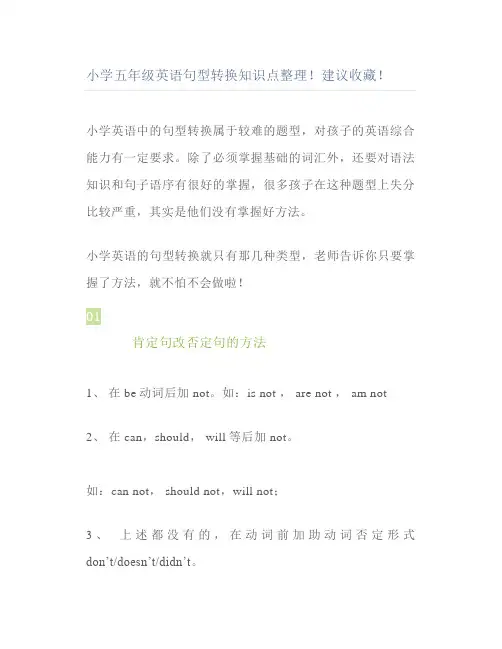
小学五年级英语句型转换知识点整理!建议收藏!小学英语中的句型转换属于较难的题型,对孩子的英语综合能力有一定要求。
除了必须掌握基础的词汇外,还要对语法知识和句子语序有很好的掌握,很多孩子在这种题型上失分比较严重,其实是他们没有掌握好方法。
小学英语的句型转换就只有那几种类型,老师告诉你只要掌握了方法,就不怕不会做啦!01肯定句改否定句的方法1、在be动词后加not。
如:is not , are not , am not2、在can,should, will等后加not。
如:can not, should not,will not;3、上述都没有的,在动词前加助动词否定形式don’t/doesn’t/didn’t。
4、 some 改成any。
如:I am a girl. → I am not a girl.You are a student. →You are not a student.→You aren’t a student.This is Tom’s bag, → This is not Tom’s bag.→ This isn’t Tom’s bag.02肯定句改一般疑问句的方法1、把be动词放在句首,剩下的照抄,(some 改成any,I改成you,my改成your)句点改成问号。
2、把can,shall, will等放到句首,剩下的照抄,(some 改成any,I改成you,my改成your)句点改成问号。
3、上述都没有的,在句首请助动词Do/Does/Did帮忙,剩下的照抄,(some 改成any,I改成you,my改成your)句点改成问号。
注意:句首的第一个字母要大写,句尾标点应为“?”。
如:I am in Clas s 6. →Are you in Class 6?You are from America. →Are you from America?It is an orange. →Is it an orange?4、就一般疑问句回答一般疑问句有两种回答,即:肯定回答和否定回答。

小学六年级英语句型转换方法归纳大全如:Do you like English?Does he speak Chinese?Did they finish their homework?第二步:将句子中的主语放在be动词或情态动词或助动词后面,动词用原形。
如:Do you like English?Does he speak Chinese?Did they finish their homework?第三步:在句子末尾加问号。
如:Do you like English?Does he speak Chinese?Did they finish their homework?三、肯定句改祈使句——两步法第一步:将句子中的主语you省略。
如:Study hard.→Hard.XXX.→Quiet.第二步:在句子末尾加上句号或感叹号。
如:Study hard.Be quiet!Original article:XXX and I went to the park yesterday。
We played catch and had a ic。
The weather was nice and sunny。
We saw some kids XXX。
We had a great time.Corrected and rewritten:XXX。
my friend and I went to the park。
We played catch and had a ic on the grass。
The weather was beautiful and sunny。
While we were there。
we saw some children flying kites and some people walking their dogs。
It was a wonderful day and we had a lot of fun.When forming a n in English。
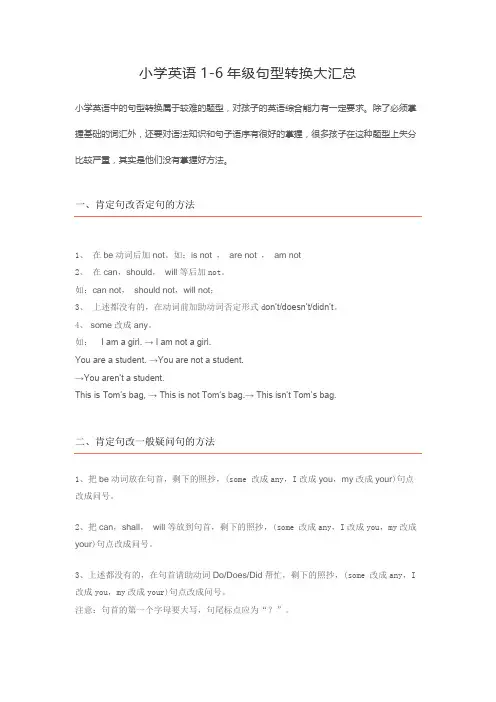
小学英语1-6年级句型转换大汇总小学英语中的句型转换属于较难的题型,对孩子的英语综合能力有一定要求。
除了必须掌握基础的词汇外,还要对语法知识和句子语序有很好的掌握,很多孩子在这种题型上失分比较严重,其实是他们没有掌握好方法。
一、肯定句改否定句的方法1、在be动词后加not。
如:is not ,are not ,am not2、在can,should,will等后加not。
如:can not,should not,will not;3、上述都没有的,在动词前加助动词否定形式d on’t/doesn’t/didn’t。
4、 some改成any。
如:I am a girl. → I am not a girl.You are a student. →You are not a student.→You aren’t a student.This is Tom’s bag, → This is not Tom’s bag.→ This isn’t Tom’s bag.二、肯定句改一般疑问句的方法1、把be动词放在句首,剩下的照抄,(some 改成any,I改成you,my改成your)句点改成问号。
2、把can,shall,will等放到句首,剩下的照抄,(some 改成any,I改成you,my改成your)句点改成问号。
3、上述都没有的,在句首请助动词Do/Does/Did帮忙,剩下的照抄,(some 改成any,I 改成you,my改成your)句点改成问号。
注意:句首的第一个字母要大写,句尾标点应为“?”。
如:I am in Class 6. →Are you in Class 6?You are from America. →Are you from America?It is an orange. →Is it an orange?4、就一般疑问句回答一般疑问句有两种回答,即:肯定回答和否定回答。
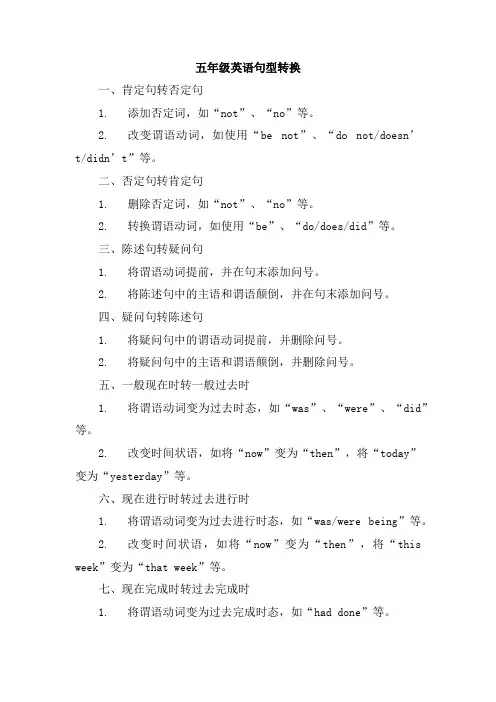
五年级英语句型转换一、肯定句转否定句1.添加否定词,如“not”、“no”等。
2.改变谓语动词,如使用“be not”、“do not/doesn’t/didn’t”等。
二、否定句转肯定句1.删除否定词,如“not”、“no”等。
2.转换谓语动词,如使用“be”、“do/does/did”等。
三、陈述句转疑问句1.将谓语动词提前,并在句末添加问号。
2.将陈述句中的主语和谓语颠倒,并在句末添加问号。
四、疑问句转陈述句1.将疑问句中的谓语动词提前,并删除问号。
2.将疑问句中的主语和谓语颠倒,并删除问号。
五、一般现在时转一般过去时1.将谓语动词变为过去时态,如“was”、“were”、“did”等。
2.改变时间状语,如将“now”变为“then”,将“today”变为“yesterday”等。
六、现在进行时转过去进行时1.将谓语动词变为过去进行时态,如“was/were being”等。
2.改变时间状语,如将“now”变为“then”,将“this week”变为“that week”等。
七、现在完成时转过去完成时1.将谓语动词变为过去完成时态,如“had done”等。
2.改变时间状语,如将“so far”变为“by then”,将“until now”变为“until then”等。
八、直接引语转间接引语1.删除直接引语中的引号,并改变人称代词。
2.将直接引语中的谓语动词变为间接引语的谓语动词形式。
3.改变时间状语和地点状语。
4.根据需要添加连词。
九、简单句转复合句1.在简单句中添加从句引导词和从句部分。
2.将简单句中的内容转移到从句中。
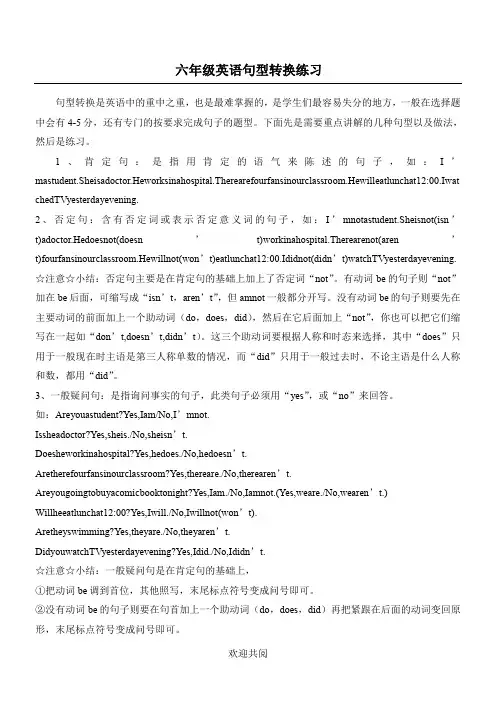
六年级英语句型转换练习句型转换是英语中的重中之重,也是最难掌握的,是学生们最容易失分的地方,一般在选择题中会有4-5分,还有专门的按要求完成句子的题型。
下面先是需要重点讲解的几种句型以及做法,然后是练习。
1、肯定句:是指用肯定的语气来陈述的句子,如:I’mastudent.Sheisadoctor.Heworksinahospital.Therearefourfansinourclassroom.Hewilleatlunchat12:00.Iwat chedTVyesterdayevening.2、否定句:含有否定词或表示否定意义词的句子,如:I’mnotastudent.Sheisnot(isn’t)adoctor.Hedoesnot(doesn’t)workinahospital.Therearenot(aren’t)fourfansinourclassroom.Hewillnot(won’t)eatlunchat12:00.Ididnot(didn’t)watchTVyesterdayevening. ☆注意☆小结:否定句主要是在肯定句的基础上加上了否定词“not”。
有动词be的句子则“not”加在be后面,可缩写成“isn’t,aren’t”,但amnot一般都分开写。
没有动词be的句子则要先在主要动词的前面加上一个助动词(do,does,did),然后在它后面加上“not”,你也可以把它们缩写在一起如“don’t,doesn’t,didn’t)。
这三个助动词要根据人称和时态来选择,其中“does”只用于一般现在时主语是第三人称单数的情况,而“did”只用于一般过去时,不论主语是什么人称和数,都用“did”。
3、一般疑问句:是指询问事实的句子,此类句子必须用“yes”,或“no”来回答。
如:Areyouastudent?Yes,Iam/No,I’mnot.Issheadoctor?Yes,sheis./No,sheisn’t.Doesheworkinahospital?Yes,hedoes./No,hedoesn’t.Aretherefourfansinourclassroom?Yes,thereare./No,therearen’t. Areyougoingtobuyacomicbooktonight?Yes,Iam./No,Iamnot.(Yes,weare./No,wearen’t.) Willheeatlunchat12:00?Yes,Iwill./No,Iwillnot(won’t).Aretheyswimming?Yes,theyare./No,theyaren’t.DidyouwatchTVyesterdayevening?Yes,Idid./No,Ididn’t.☆注意☆小结:一般疑问句是在肯定句的基础上,①把动词be调到首位,其他照写,末尾标点符号变成问号即可。

六年级英语句型转换及答案在六年级的英语学习中,学生们需要掌握并运用多种英语句型进行表达。
句型转换是提高语言运用能力的重要一环,通过对原句进行改写,学生们可以更加灵活地运用所学的语法知识来表达自己的意思。
下面将详细介绍一些常见的六年级英语句型转换,并给出相应的答案。
1. 肯定句转否定句:将肯定句改为否定句时,通常需要在动词前加上否定词not。
例如:She is my friend. → She is not my friend.2. 否定句转肯定句:将否定句改为肯定句时,通常需要去掉否定词not。
例如:He doesn't like soccer. → He likes soccer.3. 一般疑问句转陈述句:将一般疑问句改为陈述句时,通常需要用肯定或否定回答中的一个来作为答句。
例如:Do you like ice cream? → Yes, I do. / No, I don't.4. 陈述句转特殊疑问句:将陈述句改为特殊疑问句时,通常需要将疑问词放在句首。
例如:You are from China. → Where are you from?5. 一般现在时转一般过去时:将一般现在时改为一般过去时时,通常需要将动词的过去式形式。
例如:She sings well. → She sang well.6. 一般过去时转一般将来时:将一般过去时改为一般将来时时,通常需要在动词前加助动词will。
例如:They visited the museum last week. → They will visit the museum next week.7. 现在进行时转一般现在时:将现在进行时改为一般现在时时,通常需要去掉be动词,并根据主语的单复数形式来决定动词的形式。
例如:I am reading a book. → I read a book.8. 一般现在时转现在进行时:将一般现在时改为现在进行时时,通常需要在动词前加上be动词,并将动词的原形变为-ing形式。
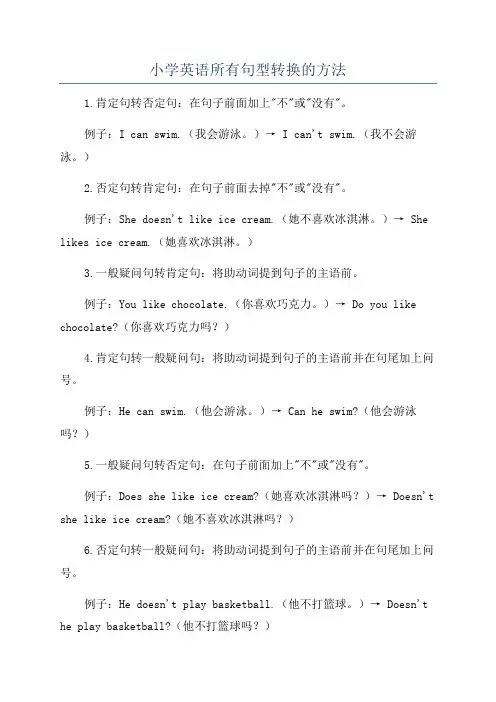
小学英语所有句型转换的方法1.肯定句转否定句:在句子前面加上"不"或"没有"。
例子:I can swim.(我会游泳。
)→ I can't swim.(我不会游泳。
)2.否定句转肯定句:在句子前面去掉"不"或"没有"。
例子:She doesn't like ice cream.(她不喜欢冰淇淋。
)→ She likes ice cream.(她喜欢冰淇淋。
)3.一般疑问句转肯定句:将助动词提到句子的主语前。
例子:You like chocolate.(你喜欢巧克力。
)→ Do you like chocolate?(你喜欢巧克力吗?)4.肯定句转一般疑问句:将助动词提到句子的主语前并在句尾加上问号。
例子:He can swim.(他会游泳。
)→ Can he swim?(他会游泳吗?)5.一般疑问句转否定句:在句子前面加上"不"或"没有"。
例子:Does she like ice cream?(她喜欢冰淇淋吗?)→ Doesn't she like ice cream?(她不喜欢冰淇淋吗?)6.否定句转一般疑问句:将助动词提到句子的主语前并在句尾加上问号。
例子:He doesn't play basketball.(他不打篮球。
)→ Doesn't he play basketball?(他不打篮球吗?)7.肯定句转选择疑问句:在句子后面加上疑问词和两个选项。
例子:They like pizza.(他们喜欢比萨饼。
)→ Do they like pizza or hamburgers?(他们喜欢比萨饼还是汉堡包?)8.选择疑问句转肯定句:根据选项的情况作肯定回答。
例子:Do you like apples or oranges?(你喜欢苹果还是橙子?)→ I like appl es.(我喜欢苹果。
四大时态温习1. 一般此刻时(1)一般此刻时的组成(肯定句)☆be动词:主语+be(am,is,are)+其它。
如:I am a boy.我是一个男孩。
☆行为动词:主语+行为动词(+其它)。
如:We study English.咱们学习英语。
☆当主语为第三人称单数(he, she,it)时,要在动词后加"-s"或"-es"。
如:Mary likes Chinese. 玛丽喜欢汉语。
(2)一般此刻时的转变☆ . be动词的转变。
[否定句]:主语+ be + not +其它。
如:He is not a worker.他不是工人。
[一般疑问句]:Be +主语+其它。
如:-Are you a student? -Yes. I am. / No, I'm not.[特殊疑问句]:疑问词+一般疑问句。
如:Where is my bike?☆ .行为动词的转变。
[否定句]:主语+ don't( doesn't ) +动词原形(+其它)。
如:I don't like bread.当主语为第三人称单数时,要用doesn't组成否定句。
如:He doesn't often play.[一般疑问句]:Do( Does ) +主语+动词原形+其它。
如:- Do you often play football?- Yes, I do. / No, I don't.当主语为第三人称单数时,要用does组成一般疑问句。
如:- Does she go to work by bike? - Yes, she does. / No, she doesn't.[特殊疑问句]:疑问词+一般疑问句。
如:How does your father go to work?*动词+s的转变规则1.一般情况下,直接加-s,如:cook-cooks, milk-milks2.以s. x. sh. ch. o结尾,加-es,如:guess-guesses, wash-washes, watch-watches, go-goes3.以“辅音字母+y”结尾,变y为i, 再加-es,如:study-studies2.此刻进行时(1)一般此刻时的组成:be(am,is, are)+ 动词的ing形式。
六年级英语句型转换知识点六年级英语句型转换知识点详解句型转换的基本原则•句型转换指的是将一种句型转变成另一种句型,通过更改句子的结构、时态、语态、人称等来达到转换的目的。
•在进行句型转换时,需要注意句子的语法规则,尤其是主谓一致、时态一致等。
一般现在时句型转换•肯定句转否定句:在句子前加上”do not”或”does not”,并改变动词原形。
•否定句转肯定句:去掉”do not”或”does not”,并改变动词原形。
•一般疑问句转陈述句:将疑问句中的疑问词替换为相应的信息。
•一般疑问句转否定句:在疑问句前加上”do not”或”does not”。
•陈述句转一般疑问句:在句首加上”Do”或”Does”。
•特殊疑问句转陈述句:将特殊疑问句中的疑问词替换为相应的信息。
•肯定句转否定句:在句子前加上”did not”,并改变动词原形。
•否定句转肯定句:去掉”did not”,并改变动词原形。
•一般疑问句转陈述句:将疑问句中的疑问词替换为相应的信息。
•一般疑问句转否定句:在疑问句前加上”did not”。
•陈述句转一般疑问句:在句首加上”Did”。
•特殊疑问句转陈述句:将特殊疑问句中的疑问词替换为相应的信息。
现在进行时句型转换•肯定句转否定句:在be动词后加上”not”。
•否定句转肯定句:去掉”not”。
•一般疑问句转陈述句:将疑问句中的疑问词替换为相应的信息。
•一般疑问句转否定句:在疑问句前加上”do not”或”does not”。
•陈述句转一般疑问句:将be动词提前至句首。
•特殊疑问句转陈述句:将特殊疑问句中的疑问词替换为相应的信息。
•肯定句转否定句:在句子前加上”will not”。
•否定句转肯定句:去掉”not”。
•一般疑问句转陈述句:将疑问句中的疑问词替换为相应的信息。
•一般疑问句转否定句:在疑问句前加上”will not”。
•陈述句转一般疑问句:在句首加上”Will”。
•特殊疑问句转陈述句:将特殊疑问句中的疑问词替换为相应的信息。
小学英语句型转换方法归纳一.陈述句改为一般疑问句1、先找be动词am,i,are,或情态动词can,may,mut,would,hould,could.如果有这些词,直接把这些词放在句子最前面,句号改成问号,其余照抄;(如果主语是第一人称则变成第二人称)2、如果句子中没有be动词或者是情态动词,要在句子最前面加助动词do、doe或者是did。
首先判断句子时态,如果句子是过去式,则要在句最前面加Did,后面动词用原型,ome改成any,句号改成问号,其余照抄;(如果主语是第一人称则变成第二人称)如果句子不是过去式,则判断是否为第三人称单数,如果第三人称单数,要在句子最前面前加助动词Doe,后面动词用原型,ome改成any,句号改成问号,其余部分照抄。
(如果主语是第一人称则变成第二人称)其他情况均要在句子最前面加助动词do,ome改成any,句号改成问号,其它部分照抄.(如果主语是第一人称则变成第二人称)二.陈述句改为否定句1、先找be动词am,i,are,wa,were或情态动词can,may,mut,would,hould,could.如果有这些词,直接在这些词的后面加not,ome改成any,其余照抄;2、如果句子中没有be动词或者是情态动词,要在动词前面加don’t、doen’t或者是didn’t。
首先判断句子时态,如果句子是过去式,则要在动词前面加didn’t,后面动词用原型,ome改成any,其余照抄;如果句子不是过去式,则判断是否为第三人称单数,如果第三人称单数,要在动词前面前加doen’t,后面动词用原型,ome改成any,其余部分照抄。
其他情况均要在句子动词前面加don’t,ome改成any,其它部分照抄.三.对划线部分提问第一步:先把句子改成一般问句第二步:把提问部分省略,在句子最前面加疑问词。
(如果提问部分是动词词组,要把它改成do;如果提问部分是动名词词组,要把它改成doing)(注:如划线部分为主语,则用who代替,其余照抄;如划线部分为动词或动词短语,则用do代替,句前加what,再改为一般疑问句(注:我I、我们we是第一人称;你you,你们you是第二人称;剩下的全部是第三人称)。
小学英语所有句型转换的方法小学学过的时态有一般现在时、一般过去时、一般将来时、现在进行时、情态动词can,句型有陈述句(包括肯定句,否定句)、疑问句(包括一般疑问句、特殊疑问句)、祈使句(包括肯定句,否定句)、感叹句(包括以How和What 开头的感叹句),虽然句型很多,但是基本助动词只有三个:be, do, have, 他们没有词汇意义,只有语法作用,如协助构成各种时态的否定句、疑问句、祈使句等。
一、肯定句改否定句的方法:一步法1、在be动词后加not。
如:is not ,are not(=aren’t),am not,was not (=wasn’t),were not(=weren’t);2、在can,should,will,have,has等后加not。
如:cannot(=can’t),should not(=shouldn’t),will not(=won’t);3、上述都没有的,在动词前加助动词否定形式don’t,doesn’t或didn’t。
4、some 改成any,and 改成or。
二、肯定句改一般疑问句的方法:三步法1、把be动词放在句首,剩下的照抄,(some 改成any,my改成your等)句号改成问号(.->?)。
2、把can,shall,will,have,has等放到句首,剩下的照抄,(some 改成any,and 改成or。
I,we,my 改成you,your等)句号改成问号。
例如:陈述句:They are in the park. He can play the guitar.一般疑问句:Are they in the park? Can he play the guitar?把下列句子变成一般疑问句1. I am listening to music._______________________________________2. Mike is a pupil._______________________________________3. Sarah can clean the classroom.________________________________________4. They are in the zoo.________________________________________5. There are some flowers in the vase.________________________________________6.This is my sister._________________________________________7.We are sweeping the floor.__________________________________________3、上述都没有的,在句首请助动词Do/Does/Did帮忙,剩下的照抄,(some 改成any ,and 改成or,I,we,my 改成you,your等)句号改成问号(.->?)。
三年级英语句型转换方法归纳三年级英语句型转换方法主要包括以下几种:1. 肯定句改否定句的方法:在be动词后加not,没有be动词则加助动词。
肯定句中有some,否定句中将其改为any。
肯定句中有and,否定句中用or替换。
2. 陈述句变一般疑问句的方法:将be动词/助动词提前,首字母大写。
疑问词+be动词/助动词+主语+其他?3. 陈述句变特殊疑问句的方法:先找出be动词或助动词,将其提前,再确定疑问词。
疑问词+be动词/助动词+主语+其他?4. “have”变“there be”结构:there be表示“存在”,have表示“拥有”。
there be +名词+地点,表示某地有某物。
5. 时态的转换:现在进行时:be+动词ing形式,表示正在进行的动作。
一般现在时:动词原形或第三人称单数形式,表示经常发生的动作或存在的状态。
一般过去时:动词过去式,表示过去发生的动作或存在的状态。
6. 人称代词的转换:主格:I(我)、you(你)、he(他)、she(她)、it(它)、we(我们)、you(你们)、they(他们)。
宾格:me(我)、you(你)、him(他)、her(她)、it(它)、us (我们)、you(你们)、them(他们)。
7. 地点介词的转换:in表示在某一范围内或在某物的里面。
on表示与某物接触或在某物的上方。
under表示在某物的下方。
near表示在某物的附近。
next to表示紧挨着某物。
8. 常用短语和表达的转换:Good morning!早上好!Good afternoon!下午好!Good night!晚安!9. 形容词和副词的比较级和最高级的转换:比较级在形容词后加-er,最高级在形容词后加-est。
一些特殊形式的比较级和最高级,如well(更好地),better(最好的),best(最好的)。
10. 特殊疑问词的转换:what什么,对物品的名称进行提问。
where哪里,对地点进行提问。
六年级英语句型转换练习句型转换是英语中的重中之重,也是最难掌握的,是学生们最容易失分的地方,一般在选择题中会有4-5分,还有专门的按要求完成句子的题型。
下面先是需要重点讲解的几种句型以及做法,然后是练习。
1、肯定句:是指用肯定的语气来陈述的句子,如:I’m a student. She isa doctor. He works in a hospital. There are four fans in our classroom. He will eat lunch at 12:00. I watched TV yesterday evening.2、否定句:含有否定词或表示否定意义词的句子,如:I’m not a student. She is not (isn’t) a doctor. He does not (doesn’t) work in a hospital. There are not (aren’t) four fans in our classroom. He will not (won’t) eat lunch at 12:00.I did not (didn’t) watch TV yesterday evening.☆注意☆小结:否定句主要是在肯定句的基础上加上了否定词“not”。
有动词be的句子则“not”加在be后面,可缩写成“isn’t,aren’t”,但am not 一般都分开写。
没有动词be的句子则要先在主要动词的前面加上一个助动词(do,does,did),然后在它后面加上“not”,你也可以把它们缩写在一起如“don’t , doesn’t , didn’t )。
这三个助动词要根据人称和时态来选择,其中“does”只用于一般现在时主语是第三人称单数的情况,而“did”只用于一般过去时,不论主语是什么人称和数,都用“did”。
3、一般疑问句:是指询问事实的句子,此类句子必须用“yes”,或“no”来回答。
小学1-6 年级英语句型转换方法归纳汇总10
第一节改为一般疑问句
1、先找be 动词am, is, are, was, were 或情态动词can, may ,must, would ,should ,could . 如果有这些词,直接把这些词放在句子最前面,some 改成any ,句号改成问号!其余照抄;(如果主语是第一人称则变成第二人称)
2、如果句子中没有be 动词或者是情态动词,要在句子最前面加助动词do 、does 或者是did 。
首先判断句子时态,如果句子是过去式,则要在句最前面加Did ,后面动词用原型,some 改成any ,句号改成问号,其余照抄;(如果主语是第一人称则变成第二人称)如果句子不是过去式,则判断是否为第三人称单数,如果第三人称单数,要在句子最前面前加助动词Does, 后面动词用原型,some 改成any ,句号改成问号,其余部分照抄。
(如果主语是第一人称则变成第二人称)其他情况均要在句子最前面加助动词do ,some 改成any ,句号改成问号,其它部分照抄. (如果主语是第一人称则变成第二人称)第二节改为否定句
1、先找be 动词am, is, are, was, were 或情态动词can, may ,must, would ,should ,could . 如果有这些词,直接在这些词的后面加not ,
some 改成any ,其余照抄;
2、如果句子中没有be 动词或者是情态动词,要在动词前面加don ' t 、doesn 't 或者是didn 't 。
首先判断句子时态,如果句子是过去式,则要在动词前面加didn 't,后面动词用原型,some 改成any ,其余照抄;如果句子不是过去式,
则判断是否为第三人称单数,如果第三人称单数,要在动词前面前加doesn ',后面动词用原型,some改成any , 其余部分照抄。
其他情况均要在句子动词前面加don ' t, some改成any ,其它部分照抄.
第三节对划线部分提问
第一步:先把句子改成一般问句第二步:把提问部分省略,在句子最前面加疑问词。
(如果提问部分是动词词组,要把它改成do ;如果提问部分是动名词词组,要把它改成doing )
(注:如划线部分为主语,则用who 代替,其余照抄;如划线部分为动词或动词短语,则用do 代替,句前加what ,再改为一般疑问句。
第四节肯定句、否定句、一般疑问句与特殊疑问句
1、肯定句:是指用肯定的语气来陈述的句子,如:
I'm a student. She is a doctor. He works in a hospital. There are four fans in our classroom..
2、否定句:含有否定词或表示否定意义词的句子,如:
I'm not a student. She is not (isn ' t) a doctor. He does not (doesn ' t) work in a hospital. There are not (aren 't) four fans in our classroom.
☆注意小结:否定句主要是在肯定句的基础上加上了否定词“ not ”。
有动词be的句子则“not ”加在be后面,可缩写成“isn ' t, aren ' t”,但am not 一般都分开写。
没有动词be的句子则要先在主要动词的前面加上一个助动词(do,does,did ),然后在它后面加上
“ not ”,你也可以把它们缩写在一起如“ don ' t , doesn ' t , didn ' t )。
这三个助动词要根据人称和时态来选择,其中“ does ”只用于一般现在时主语是第三人称单数的情况,而“ did ”只用于一般过去时,不论主语是什么人称和数,都用“ did ”。
3、一般疑问句:是指询问事实的句子,此类句子必须用“yes ”,或“no”来回答。
如:
Are you a student? Yes, I am / No, I ' m not.
Is she a doctor? Yes, she is. / No, she isn ' t.
Does he work in a hospital? Yes, he does. / No, he doesn ' t. Are there four fans in our classroom? Yes, there are. / No,
there aren ' t.
☆注意小结:一般疑问句是在肯定句的基础上:①把动词be调到首
位,其他照写,末尾标点符号变成问号即可。
②没有动词be的句子则要在句首加上一个助动词( do ,does ,did )再把紧跟在后面的动词变回原形,末尾标点符号变成问号即可。
这三个助动词也要根据人称和时态来选择,其中“ does ”只用于一
般现在时主语是第三人称单数的情况,而“did ”只用于一般过去时, 不论主语是什么人称和数,都用“ did ” 。
一般疑问句有个重要的原则就是问和答要一致,即问句里的第一个单词(助动词)和简略答句里的这个词是一致的。
4、特殊疑问句:以特殊疑问词(what , where , who , which , when , whose , why , how 等)开头引导的句子。
此类句子应该问什么就答什么,不能用“ yes 、no ”来回答。
如:
What is this? It 's a computer. Where are you going? I 'm going to Beijing.
What does he do? He ' s a doctor. Which season do you like
best? Summer.
Who played football with you yesterday afternoon? Mike.
When do you usually get up? I usually get up at 6:30.
Why do you like spring best? Because I can plant trees.
How did you go to Xinjiang? I went to Xinjiang by train.
☆其中how 又可以和其他一些形容词连用组成特殊疑问词组用来提
问,如:
how many (多少(数量))how much (多少(钱))how tall (多高)how long (多长)how big (多大)how heavy (多重)例句:How many pencils do you have? I have three pencils.
How many girls can you see? I can see four girls.
How many desks are there in your classroom? There are 51.
☆小结:how many 用来提问可数名词的数量,主要有以上三种句式搭配,
How ma ny + 名词复数+ do you have? 你有多少 ... ?
How ma ny + 名词复数+ can you see? 你能看见多少.... ?
How many + 名词复数+ are there …?有多少.... ?
第五节其它需要注意点
一、学生易错词汇
1. a, an 的选择:元音字母开头的单词(名词)用a n ,辅音字母开头
的单词(名词)用 a.
2. am , is , are 的选择: 单数用is , 复数用are. I 用am , you 用are.
3. have , has 的选择: 表示某人有某物。
单数用has , 复数用have.
I , you 用have .
4. there is, there are 的选择:表示某地有某物,某人。
单数用there
is , 复数用there are.
5. some, any 的选择:肯定句用some, 疑问句和否定句用any.
6. 疑问词的选择:what (什么) who (谁) where (哪里) whose (谁的) why (为什么)when(什么时候)which (哪一个)how old (多大) how many (多少)how much (多少钱)
二、完全、缩略形式: I'm=I am he 's=he is she 's=she is they '
re=they are you 're=you are there 's=there is they 're=they are
t=do not doesn 't=does not isn 't=is not 's=let us won 't=will not I 'll=I will wasn ' 'm 即 am , 's 即 is (但 let ' s=let us ) , 're
(但 can ' t=can not ) can 't=can not don aren 't=are not let t=was not 总结:通常情况下, 即 are ,
n't 即 not。